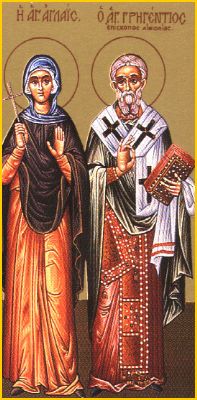|
|||
|---|---|---|---|
| This weekly bulletin insert complements the curriculum published by the Department of Christian Education of the Orthodox Church in America. This and many other Christian Education resources are available at http://dce.oca.org. | |||

The Church remembers two saints, the patrician Roman woman Aglaida and her male slave Boniface, who lived in the fourth century. Aglaida and her slave lived together as lovers. He was known as a genial person, willing to help anyone in need, but he was often drunk. She, the daughter of a Roman senator, had been raised with a strong attachment to luxury and ease and was accustomed to having her own way. As pagans, they had little use for the morality of the Christian faith. But Aglaida began to have pangs of conscience about the life she shared with Boniface. She had heard about Christians, who were said to live admirable lives, and she had also heard that some people kept relics of Christian martyrs in their homes as a way of helping themselves to become more virtuous. She sent Boniface, with some companion slaves and supplied with gold, to the area east of Rome where Christians were suffering terrible persecution, and instructed him to bring back relics. Though ready to do as his mistress wished, Boniface couldn't help joking about the whole enterprise. He said lightly to Aglaida, "Suppose I cannot find any martyrs or relics, and instead I bring back my own martyred body to you. Will you honor me as a saint?" Arriving in Tarsus, Boniface left his companions at the inn where they were staying and set off to the center of town. Since this was the place where they were torturing Christians, he thought it would also be a good place to find some relics. But he was completely unprepared for what he would see, and for his own reaction. The savagery of the persecution was gruesomely fascinating to watch. Yet what riveted his gaze was not the torture, but the luminous, serene faces of the praying martyrs. Boniface perceived that such radiant composure and bravery in suffering could only be inspired by the true God. He ran to kiss the martyrs' feet, and begged to be allowed to suffer with them. It wasn't long before he was bound, tortured, and finally beheaded. Meanwhile, his companions began wondering where he was. They assumed he had gotten drunk as usual, but began to fear that he might be in trouble. Going to look for him, they were astonished to meet a witness who told them that he had died a martyr with a group of Christians. The man led them to Boniface's decapitated body, which they took back to Rome. Aglaida received the new martyr with solemn reverence. She built a church to honor him, sold her possessions, and lived the rest of her life in quiet repentance in a monastery. In an angelic vision she was assured that through the prayers and blood of her martyred slave, now a brother to the angels, her own sins had been washed away. |
|||
